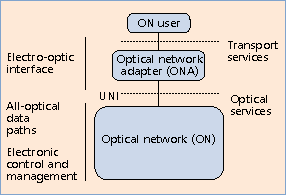New optical switch could lead to ultrafast
all-optical signal processing

Engineers at Caltech
have developed a switch—one of the most fundamental components of
computing—using optical, rather than electronic, components. The
development could aid efforts to achieve ultrafast all-optical
signal processing and computing.
Optical devices have the capacity to transmit signals far faster
than electrical devices by using pulses of light rather than
electrical signals. That is why modern devices often employ optics
to send data; for example, think of the fiberoptic cables that
provide much faster internet speeds than conventional Ethernet
cables.
The field of optics has the potential to revolutionize computing by
doing more, at faster speeds, and with less power. However, one of
the major limitations of optics-based systems at present is that, at
a certain point, they still need to have electronics-based
transistors to efficiently process the data.
Now, using the power of optical nonlinearity (more on that later), a
team led by Alireza Marandi, assistant professor of electrical
engineering and applied physics at Caltech, has created an
all-optical switch. Such a switch could eventually enable data
processing using photons. The research was published in the journal
Nature Photonics on July 28.
Switches are among the simplest components of a computer. A signal
comes into the switch and, depending on certain conditions, the
switch either allows the signal to move forward or halts it. That
on/off property is the foundation of logic gates and binary
computation, and is what digital transistors were designed to
accomplish. However, until this new work, achieving the same
function with light has proved difficult. Unlike electrons in
transistors, which can strongly affect each other's flow and thereby
cause "switching," photons usually do not easily interact with each
other.
Two things made the breakthrough possible: the material Marandi's
team used, and the way in which they used it. First, they chose a
crystalline material known as lithium niobate, a combination of
niobium, lithium, and oxygen that does not occur in nature but has,
over the past 50 years, proven essential to the field of optics. The
material is inherently nonlinear: Because of the special way the
atoms are arranged in the crystal, the optical signals that it
produces as outputs are not proportional to the input signals.
While lithium niobate crystals have been used in optics for decades,
more recently, advances in nanofabrication techniques have enabled
Marandi and his team to create lithium niobate-based integrated
photonic devices that allow for the confinement of light in a tiny
space. The smaller the space, the greater the intensity of light
with the same amount of power. As a result, the pulses of light
carrying information through such an optical system could provide a
stronger nonlinear response than would otherwise be possible.
Marandi and his colleagues also confined the light temporally.
Essentially, they decreased the duration of light pulses, and used a
specific design that would keep the pulses short as they propagate
through the device, which resulted in each pulse having higher peak
power.
The combined effect of these two tactics—the spatiotemporal
confinement of light—is to substantially enhance the strength of
nonlinearity for a given pulse energy, which means the photons now
affect each other much more strongly.
The net result is the creation of a nonlinear splitter in which the
light pulses are routed to two different outputs based on their
energies, which enables switching to occur in less than 50
femtoseconds (a femtosecond is a quadrillionth of a second). By
comparison, state-of-the-art electronic switches take tens of
picoseconds (a picosecond is a trillionth of a second), a difference
of many orders of magnitude.
New optical switch could lead to ultrafast all-optical signal
processing (phys.org)
Femtojoule femtosecond all-optical switching in lithium niobate
nanophotonics | Nature Photonics
About TACS
TACS
Consulting Delivers The Insight and Vision on Information
Communication and Energy Technologies for Strategic Decisions.
TACS is Pioneer and Innovator of many Communication Signal
Processors, Optical Modems, Optimum or Robust Multi-User or
Single-User MIMO Packet Radio Modems, 1G Modems, 2G Modems, 3G
Modems, 4G Modems, 5G Modems, 6G Modems, Satellite Modems, PSTN
Modems, Cable Modems, PLC Modems, IoT Modems and more..
TACS consultants conducted fundamental scientific research in
the field of communications and are the pioneer and first
inventors of PLC MODEMS, Optimum or Robust Multi-User or
Single-User MIMO fixed or mobile packet radio structures in the
world.
TACS is a leading top consultancy in the field of Information,
Communication and Energy Technologies (ICET). The heart of our
Consulting spectrum comprises strategic, organizational, and
technology-intensive tasks that arise from the use of new
information and telecommunications technologies. TACS Consulting
offers Strategic Planning, Information, Communications and
Energy Technology Standards and Architecture Assessment, Systems
Engineering, Planning, and Resource Optimization.
|
TACS is a leading top consultancy in the field of information, communication
and energy technologies (ICET).
The heart of our consulting spectrum comprises strategic,
organizational, and technology-intensive tasks that arise from the use of new
information, communication and energy technologies.
The major emphasis in our work is found in innovative consulting and
implementation solutions which result from the use of modern information,
communication and energy technologies.
TACS
- Delivers the insight and vision
on technology for strategic decisions
- Drives
innovations forward as part of our service offerings to customers
worldwide
- Conceives
integral solutions on the basis of our integrated business and technological
competence in the ICET sector
- Assesses technologies and standards and develops
architectures for fixed or mobile, wired or wireless communications systems
and networks
- Provides
the energy and experience of world-wide leading innovators and experts in their fields for local,
national or large-scale international projects.
|